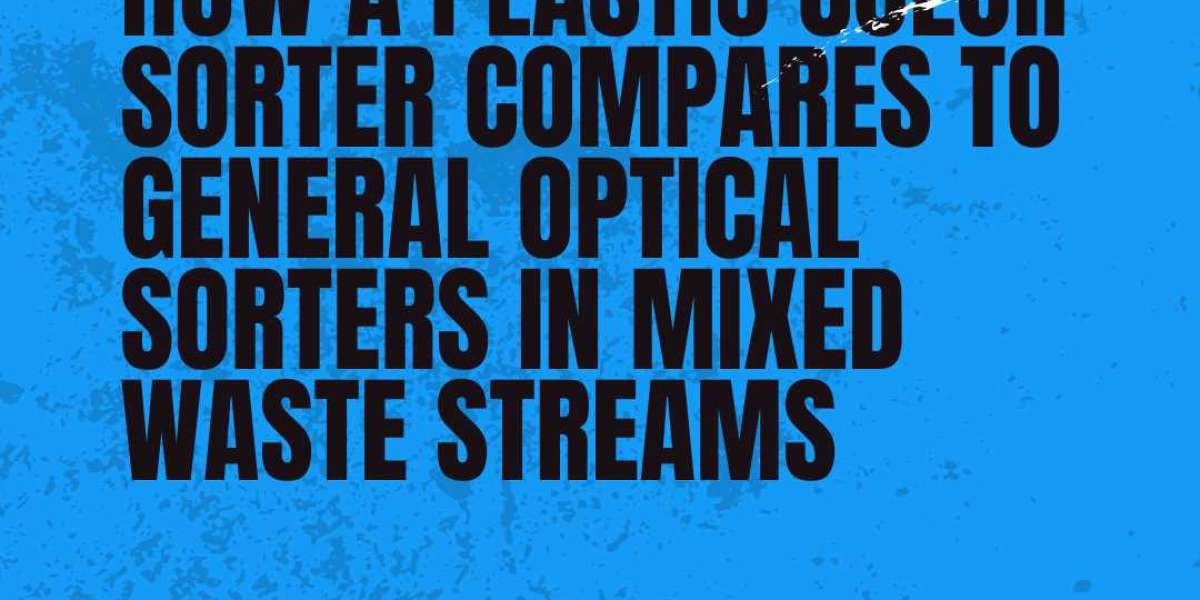How a Plastic Color Sorter Stacks Up to General Optical Sorters in Mixed Waste Streams
In the fast-paced, ever-changing recycling and waste management sector of today, the need for accurate and effective material separation has never been greater. Companies worldwide are looking at intelligent automation technologies that can assist them with maintaining higher purity rates and enhanced resource recovery. Such a cutting-edge technology is the "Plastic Color Sorter," a sophisticated machine that is uniquely designed to separate and sort out plastic materials according to color and resin type. If you are now in need of a plastic sorting machine for sale, you should definitely consider a specialty solution like what Mark Color Sorter provides.
Unlike traditional or general optical sorters, plastic color sorters are built with highly focused sensors and algorithms tailored for plastic recognition, resulting in higher efficiency and cleaner outputs in mixed waste environments. This article will delve into how a plastic color sorter stacks up against general optical sorters, especially when tackling the complex nature of mixed waste streams. We'll also discuss how this cutting-edge sorting technology applies across other industries—such as food sorting and farm automation.
Specialized vs. General: The Essential Differences
General optical sorters, although universal, tend not to have the precise sensitivity needed to cope with plastics' subtle variations, especially in a mixed waste stream. Optical sorters use simple color and shape recognition, which may be adequate in uniform streams such as grain sorting but are insufficient when separating plastics of similar colors or composite items.
Mark Color Sorter's Plastic Color Sorter stands out due to its use of high-resolution cameras, artificial intelligence-based image processing, and NIR (near-infrared) sensors to sort and classify plastics more precisely. It can distinguish between PET, HDPE, PVC, and other resins regardless of them being colored alike or being partially contaminated.
Contrarily, general optical sorters are challenged by uncertain objects and will produce more error when sorting mixed streams of waste. This results in inefficiencies, lower product quality, and the requirement for secondary sorting, raising costs of operation.
Cross-Industry Technology Inspiration: Lessons from Cashew Sorting
It is noteworthy that most of the advances in plastic color sorting have been adapted from food processing technologies, specifically nut sorting. Devices such as the CASHEW NUT SORTING MACHINE have set the benchmark for the application of multispectral imaging and real-time decision-making to sort out defective nuts, foreign bodies, or even minor color variations.
Mark Color Sorter followed the same path, using multi-wavelength and RGB+IR (infrared) camera technologies to sort plastic. This guarantees even plastics with slight differences—faded labels, ink marks, or light soiling—are sorted. The possibility of adjusting the sorting thresholds makes these machines exceptionally beneficial for those industries in need of high-purity output for recycling.
So although the application varies, the precision developed in the food industry has significantly impacted the way plastic sorting machines operate today. That is why a specialized plastic color sorter far exceeds generic machines when sorting diversified and contaminated streams of plastic.
Real-World Applications in Nut Processing: Almond Sorting Machine Comparison
To better see the advantage of specialization, let's take another example of a nut industry innovation: the Almond Sorting Machine. These machines sort and reject a variety of defects—shell pieces to moldy kernels. They contain advanced calibration features that are tailored to the unique profile of almonds, which are different from those of cashews, walnuts, or peanuts.
Likewise, plastic color sorters need to be calibrated to distinguish various kinds of plastics with certain optical and material characteristics. For instance, Mark Color Sorter's plastic color sorter can sort out clear PET bottles from green or brown bottles, and detect and reject multilayer plastics or non-plastic contaminants.
The application of a generic optical sorter in either of these situations—in nut processing or in recycling plastics—would undermine sorting precision and enhance contamination levels. As almond manufacturers also make investments in equipment specifically designed for almonds, the same should be done by recycling enterprises in favor of specialized plastic color sorters instead of generic units.
What Makes Mark Color Sorter Different from Other Color Sorting Machine Companies
The sorting equipment market is extensive, and there are plenty of color sorting machine makers competing for your attention. Mark Color Sorter differentiates itself, though, through its industry-specific customization and intimate knowledge of the materials being sorted.
Numerous generic producers offer one-size-fits-all machines that guarantee wide-ranging application across industries from agriculture through recycling. In reality, however, this generality means subpar performance. Mark Color Sorter, by contrast, has dedicated its RD efforts to developing purpose-designed solutions such as the Plastic Color Sorter, producing results that satisfy the high standards of today's recycling plants.
Further, Mark Color Sorter offers real-time remote diagnostics, after-sales service, and user-friendly interfaces to ensure that your machine functions at peak performance over time. It also gives customized training programs for operators to ensure that companies can tap into the maximum potential of their equipment.
The Economic and Environmental Payoff
Purchasing a single-stream plastic color sorter not only maximizes sorting precision but also maximizes ROI. Higher levels of purity enable recyclers to obtain higher prices for sorted plastics, decrease landfill input, and minimize processing costs. In addition, the integrated workflow bypasses manual pre-sorting that is both expensive and time-consuming.
General optical sorters can seem more cost-effective at first, but the concealed costs—wasted recovery, greater contamination, more labor—quickly add up. In the long run, companies with plastic-specific sorters such as those of Mark Color Sorter have improved fiscal and environmental results.
Use Case: Mixed Plastic Waste in Municipal Recycling Facilities
Municipal waste streams are notoriously problematic, frequently consisting of a disorganized assortment of plastics, metals, glass, and organics. Efficient separation of these materials is difficult, particularly when plastics exist in a variety of shape, size, and color tones.
Mark Color Sorter's Plastic Color Sorter has been implemented with success in a number of municipal buildings to sort and identify plastic waste automatically. Through AI and neural network-based algorithms, the machines learn and adapt to the specific material profiles of a location, allowing constant upgrading and increased recovery rates.
By contrast, general optical sorters would need regular recalibration, take higher reject rates, and necessitate more downstream sorting—meaning lower efficiency and increased costs.
Beyond Recycling: Flexibility Across Industries
Though the Plastic Color Sorter is designed to optimally sort plastic waste, the fundamental technology employed by Mark Color Sorter has multiple applications. The company has a diversified portfolio that includes sophisticated sorters for agricultural produce such as grains, nuts, pulses, and even seafood.
For instance, the same image processing core applied in the cashew nut sorter and almond sorter has been repurposed for application in plastic sorting by changing software parameters and sensitivity of sensors. Such a degree of cross-functional design indicates the brand's resourcefulness and flexibility.
It also guarantees prospective consumers that they are investing in technology supported by years of cross-industry know-how—not an isolated prototype from a run-of-the-mill machine manufacturer.
Conclusion: Opt for Specialization Rather than Generalization
In the context of processing plastics in a mixed waste stream, general-purpose optical sorters are just not up to the task compared to the precision, productivity, and ROI of a specialized Plastic Color Sorter. Mark Color Sorter has designed its machines to address the actual conditions of today's waste management and recycling markets.
From leveraging experience gained in food and nut processing to spearheading innovation in the producers of color sorting machines, Mark Color Sorter is living testimony to specialization resulting in improved outcomes. If you are looking for a plastic sorting machine for sale, investing in one that does more than the basics and offers high-precision, high-yield sorting is the way to go now.








